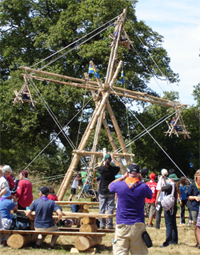
Introduction
Some useful gadgets that will be handy in and around the campfire area.
Pot Rod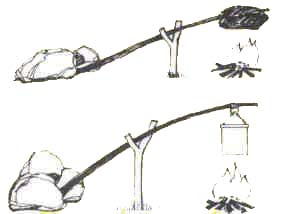
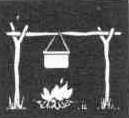
A common way of constructing access to the fire is build a simple rail over the top. This is fine except that the height (and hence the heat and cooking time) is fixed, and adding/removing items to the rail can be a tricky business. With a simple rail, if you are not using hooks to attach the pots you must remove the rail and slide the (full of hot water) pot along to the end, tricky and sometimes dangerous.
A much better way of placing your cooking pots where you want them is to construct a pot rod. First you drive a strong and sturdy forked stick into the ground near the fire, so that the forked part is upright. Be careful in your placement, obviously you do not want it so close to the fire that it catches alight. Then take a longer stick and rest it across the fork so that the end is over the fire. Secure the other end by driving it into the ground and resting heavy rocks upon it (or even by driving another forked stick across it to hold it down).
Swinging Pot Rod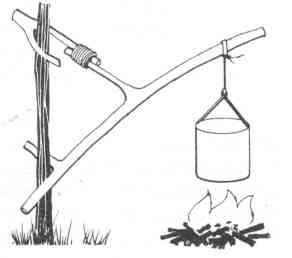
A swinging pot rod is an extremely useful version of the simple pot rod. An excellent gadget to make at camp it will make those open- fire cooking tasks much easier.
The idea is a simple thing. Find yourself two stout forked sticks. One of these must be a longish stick with two forks along its length (see diagram, all will be clear!). Drive a firm upright into the ground. Now lash together your two forked sticks so that the forks fit in opposite directions on the upright.
This will produce a cantilever action which not only will maintain the height that you set it at, but will also swing freely allowing you to move the pot away from the flames with ease. Also note that with a longer upright, you can also control the cooking height.
As with the simple pot rod secure the pots by either notching a groove or by firmly lashing a hook onto the end of the rod.
Pot Hook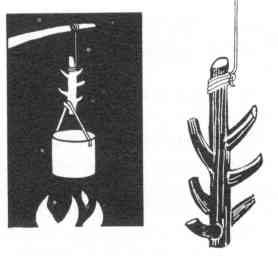
Being able to control the speed at which your meal is cooking is vital. You can do this to a certain extent by controlling the fire and embers, but by far the easiest way is to control where you place your meal on and around the fire. A pot hook that allows you to vary the height of your pot above the fire is going to let you control the cooking time.
A variable pot hook is so simple to construct its unbelievable. Simple find yourself a strong piece of wood with several branches (the more the better) from a small tree or bush. Trim the branches off so that 'stumps' of around 10cm (4 inches) are left. Secure the top of the hook using a suitable lashing/knot and attach to your pot rod (you have made one have'nt you?).
A few words of warning. Be careful to strip off the bark as this may be hiding what is in fact a rotten branch. As always, please take note of the campsites rules regarding obtaining wood. I don't think most wardens would be pleased if you start hacking down branches from live trees to make your gadgets.
Wood Store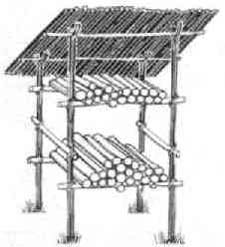
A simple wood shed can be the best gadget you will build for your campfire. When the morning comes and all the others are trying to light their kindling that has been soaked overnight, you can cooly walk up to your perfectly dry wood store and proceed to make breakfast and a nice cup of tea, put your feet up and watch everyone else struggle.
The idea is a simple one. Lash together a frame around uprights driven into the ground (be sure to make the front two uprights longer than the back two to form a sloping roof frame). If your uprights have forked ends you can simple lay a pole across between them to support the roof.. Be sure to lash some poles across to form several shelves. Construct a roof and lay across the top of your frame.
You now have a simple waterproof store for your wood. I suggest your store your wood in 'grades' from large to small. Be sure to include plenty of dry kindling, you will need it. It may be sensible to place the larger grades at the top, and the kindling on the lower shelves, just in case the roof does leak a little. For a perfectly dry wood store, construct side and front panels, or cover in plastic sheeting.
